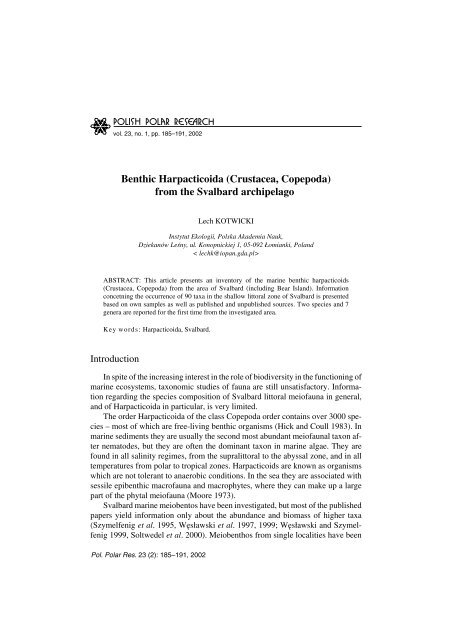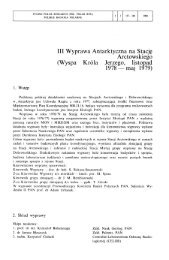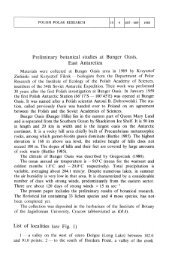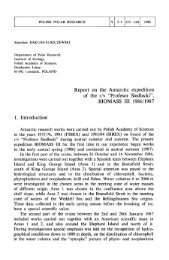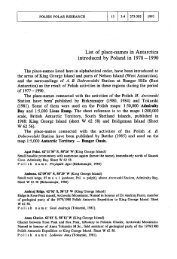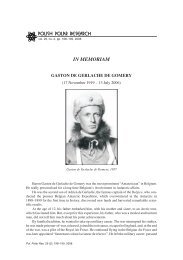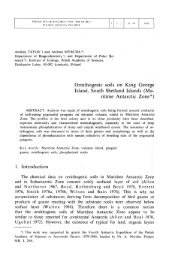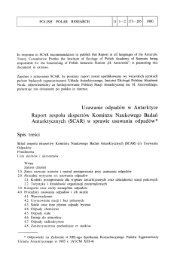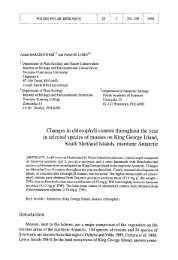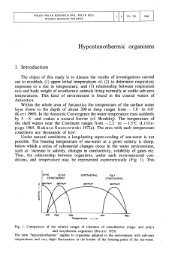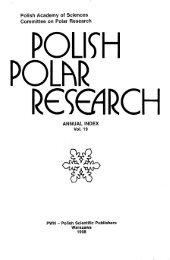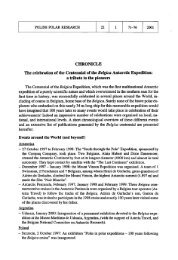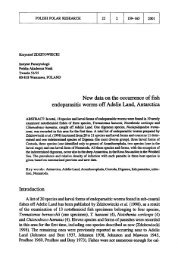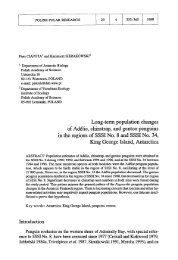Benthic Harpacticoida (Crustacea, Copepoda) from ... - Luciopesce.net
Benthic Harpacticoida (Crustacea, Copepoda) from ... - Luciopesce.net
Benthic Harpacticoida (Crustacea, Copepoda) from ... - Luciopesce.net
You also want an ePaper? Increase the reach of your titles
YUMPU automatically turns print PDFs into web optimized ePapers that Google loves.
vol. 23, no. 1, pp. 185–191, 2002<br />
<strong>Benthic</strong> <strong>Harpacticoida</strong> (<strong>Crustacea</strong>, <strong>Copepoda</strong>)<br />
<strong>from</strong> the Svalbard archipelago<br />
Lech KOTWICKI<br />
Instytut Ekologii, Polska Akademia Nauk,<br />
Dziekanów Leśny, ul. Konopnickiej 1, 05−092 Łomianki, Poland<br />
< lechk@iopan.gda.pl><br />
ABSTRACT: This article presents an inventory of the marine benthic harpacticoids<br />
(<strong>Crustacea</strong>, <strong>Copepoda</strong>) <strong>from</strong> the area of Svalbard (including Bear Island). Information<br />
concetning the occurrence of 90 taxa in the shallow littoral zone of Svalbard is presented<br />
based on own samples as well as published and unpublished sources. Two species and 7<br />
genera are reported for the first time <strong>from</strong> the investigated area.<br />
Key words: <strong>Harpacticoida</strong>, Svalbard.<br />
Introduction<br />
In spite of the increasing interest in the role of biodiversity in the functioning of<br />
marine ecosystems, taxonomic studies of fauna are still unsatisfactory. Informa−<br />
tion regarding the species composition of Svalbard littoral meiofauna in general,<br />
and of <strong>Harpacticoida</strong> in particular, is very limited.<br />
The order <strong>Harpacticoida</strong> of the class <strong>Copepoda</strong> order contains over 3000 spe−<br />
cies – most of which are free−living benthic organisms (Hick and Coull 1983). In<br />
marine sediments they are usually the second most abundant meiofaunal taxon af−<br />
ter nematodes, but they are often the dominant taxon in marine algae. They are<br />
found in all salinity regimes, <strong>from</strong> the supralittoral to the abyssal zone, and in all<br />
temperatures <strong>from</strong> polar to tropical zones. Harpacticoids are known as organisms<br />
which are not tolerant to anaerobic conditions. In the sea they are associated with<br />
sessile epibenthic macrofauna and macrophytes, where they can make up a large<br />
part of the phytal meiofauna (Moore 1973).<br />
Svalbard marine meiobentos have been investigated, but most of the published<br />
papers yield information only about the abundance and biomass of higher taxa<br />
(Szymelfenig et al. 1995, Węsławski et al. 1997, 1999; Węsławski and Szymel−<br />
fenig 1999, Soltwedel et al. 2000). Meiobenthos <strong>from</strong> single localities have been<br />
Pol. Polar Res. 23 (2): 185–191, 2002
186 Lech Kotwicki<br />
0 o VEST SPITSBERGEN<br />
10 o<br />
20 o 30 o 40 o<br />
E<br />
80 o<br />
Kongsfjorden<br />
78 o<br />
Isfjorden<br />
Sassenfjorden<br />
Adventfjorden<br />
Longyearbyen<br />
EDGEOYA<br />
Nottinghambukta<br />
Hornsund<br />
76 o<br />
SVALBARD<br />
0 100 km<br />
o<br />
74 N<br />
Bjornoya<br />
Fig. 1. Location of sampling sites.<br />
described in detail, e.g. by Radziejewska and Stankowska−Radziun (1979) and<br />
Kendall et al. (1997). The first observations on the harpacticoids <strong>from</strong> the Arctic<br />
seas were published by Scott and Scott (1901), and Lang (1936). An important de−<br />
scriptions of the benthic littoral harpacticoids <strong>from</strong> Svalbard was published by<br />
Mielke (1974). There are only a few papers giving detailed information on the spe−<br />
cies’ level (Gee and Huys 1994, Gulliksen et al. 1999).<br />
The aim of this article is to present a synopsis of the occurrence of Harpacti−<br />
coida in the littoral of Svalbard. The data is based on the author’s own unpublished<br />
results, supplemented with existing information: <strong>from</strong> both published and unpub−<br />
lished sources.<br />
Study area<br />
The shallow littoral zone of the Svalbard archipelago between 74° – 81° N and<br />
10° – 30° E (Fig. 1) was studied. The littoral zone of Svalbard is harsh but by no
<strong>Benthic</strong> <strong>Harpacticoida</strong> <strong>from</strong> the Svalbard 187<br />
means barren (Węsławski et al. 1993, 1997; Szymelfenig et al. 1995). Sea ice cov−<br />
ers almost the whole coast during winter time and disappears only on the west coast<br />
in the summer due to the influence of warm Atlantic water (Coachman and<br />
Aagaard 1974). Most shores are influenced by melt water and sediment <strong>from</strong> gla−<br />
ciers. Bjornoa is an island, isolated <strong>from</strong> the rest of archipelago, situated at 74°N<br />
and 17°E. It’s a rocky pear−shaped island some 20 km in diameter, surrounded by<br />
extensive shallows below 100 m depth.<br />
The samples of Mielke (1974) were collected <strong>from</strong> the littoral zone of the<br />
Longyearbyen (Isfjorden) and Ny Alesund (Kongsfjorden) regions. In July 1990<br />
an ecological study of latitudinal gradients in the structure of sub−littoral meio−<br />
benthos was conducted in Sassenfjord by Gee and Huys (1994). In the period<br />
1999–2001 meiofauna samples were collected by the author in Kongsfjorden,<br />
Hornsund, and Bjornoya.<br />
Sampling<br />
Meiofauna was sampled on a sandy beach, in the intertidal and shallow littoral<br />
– between 2 and 30 meters depth – by means of a steel tube of 2 cm diameter, in−<br />
serted into the sediment down to a depth of 10 cm and preserved in a 4% buffered<br />
formaldehyde and seawater solution. The extraction of the meiofauna <strong>from</strong> the<br />
sediment was done according to the standard method of decantation (Pfanekuche<br />
and Thiel 1988). Organisms were washed on 0.038 mm sieves and stained with<br />
Bengal Rose.<br />
The taxonomy of harpacticoid copepods is still unresolved. Until now the<br />
monograph by Lang (1948) remains the most important identification key. Other<br />
useful works are the monographs of Sars (1911, 1921), Smirnov (1946), Lang<br />
(1965), Huys et al. (1996), and a catalogue of the new marine harpacticoid<br />
copepods by Bodin (1997).<br />
Results and discussion<br />
Until the present time 34 species and 51 genera of <strong>Harpacticoida</strong> have been re−<br />
corded <strong>from</strong> the Svalbard archipelago (Table 1). A comparison of the species list<br />
<strong>from</strong> Mielke (1974), Gee and Huys (1994 and unpublished data), Gulliksen et al.<br />
(1999) and the author’s own samples reveals considerable differences. The highest<br />
number of taxa (49) was recorded by Gee and Huys (1994 and unpublished data) in<br />
the Sassenfjord region. In Kongsfjorden and Isfjorden Mielke (1974) identified 26<br />
species of <strong>Harpacticoida</strong>. In the entire area of study Gulliksen et al. (1999) reported<br />
only 3 species of <strong>Harpacticoida</strong>. The author’s material yielded a total of 21 taxa, in−<br />
cluding 2 species and 7 genera reported <strong>from</strong> the region for the first time.
188 Lech Kotwicki<br />
Table 1<br />
List of harpacticoid taxa <strong>from</strong> Svalbard archipelago, expected number of species in brack−<br />
ets. Data <strong>from</strong>: A – Mielke (1974), B – Gee and Huys (1994) and unpublished data,<br />
C – Gulliksen et al. (1999), D – own data.<br />
Family Taxon A B C D<br />
Longipediidae Longipedia sp. +<br />
Ectinosomatidae Ectinosoma melaniceps Boeck, 1865 +<br />
Ectinosoma sp. (1) +<br />
Halectinosoma sp. (5) + +<br />
Bradya sp. (3) + +<br />
Parabradya sp. (2) +<br />
Microsetella sp. +<br />
Sigmatidium parvulum Mielke, 1974 +<br />
Pseudobradya sp. (2) +<br />
Tachididae Tachidius discipes Giesbrecht, 1881 + +<br />
Tachidius incisipes Klie, 1913 +<br />
Tachidius sp. +<br />
Harpacticidae Harpacticus chelifer (O.F. Müller, 1776) +<br />
Harpacticus sp. +<br />
Tisbidae Tisbe furcata (Baird, 1837) +<br />
Scutellidium hippolytes (Kroyer, 1863) +<br />
Scutellidium sp. (1) + +<br />
Zosime sp. (1) +<br />
Tachidiella sp. (1) +<br />
Idyanthedilatata Sars, 1905 +<br />
Idellopsis sp. (1) +<br />
Tegasidae Tegastes sp. +<br />
Thalestridae Parathalestris sp. (1) +<br />
Dactylopodia vulgaris Sars, 1905 +<br />
Dactylopedia longyearbyensis (Mielke, 1974) +<br />
Idomene sp. (1) +<br />
Dactylopodella sp. (1) +<br />
Parastenheliidae Parastenhelia spinosa (Fisher, 1860) +<br />
Diosaccidae Stenhelia (St.) sp. (1) + +<br />
Stenhelia (D) sp. (1) + +<br />
Amphiascus minutus (Claus, 1863) +<br />
Amphiascus tenuiremis (Brady et Robertson, 1875) +<br />
Amonardia arctica (T. Scott, 1898) +<br />
Paramphiascopsis sp. (1) +<br />
Typhlamphiascus lammelifer (Sars) capensis (f) Kunz, 1975 +<br />
Typhlamphiascus sp. (2) +<br />
Amphiascoides nanus (Sars, 1906) +<br />
Amphiascoides sp. (1) +<br />
Paramphiascella sp. (1) +<br />
Haloschizopera sp. (1) +<br />
Schizopera ornata Noodt et Parasjoki, 1953 +<br />
Schizopera meridionalis Petkowski, 1954 +
<strong>Benthic</strong> <strong>Harpacticoida</strong> <strong>from</strong> the Svalbard 189<br />
Table 1 – continued.<br />
Family Taxon A B C D<br />
Ameridae Amerira longipes Boeck, 1864 +<br />
Ameira parvula (Claus, 1866) +<br />
Ameira sp. + +<br />
Pseudoameira sp. +<br />
Paramesochridae Paramesochra sp. +<br />
Canthocamptidae Mesochra schmidti Mielke, 1974 +<br />
Mesochra sp. + +<br />
Heteropsyllus sp. +<br />
Mesopsyllus sp. +<br />
Bathycamptus sp. +<br />
Cletodidae Cletodes longicaudatus (Boeck, 1872) +<br />
Cletodes sp. (3) + +<br />
Monocletodes sp. (1) +<br />
Stylicletodes sp. (1) +<br />
Paranannopidae Pseudomesochra sp. (2) +<br />
Danielssenia quadriseta Gee, 1988 +<br />
Danielssenia spitsbergensis Gee et Huys, 1994 +<br />
Psammis kliei Smirnov, 1946 +<br />
Paradanielssenia kathleenae Gee et Huys, 1994 +<br />
Paradanielssenia christineae Gee et Huys, 1994 +<br />
Mucrosenia kendalli Gee et Huys, 1994 +<br />
Huntemanniidae Nannopus palustris Brady, 1880 +<br />
Rhizothricidae Rhizothrix sp. +<br />
Argestidae Eurycletodes similis (T. Scott, 1895) +<br />
Eurycletodes (E) sp. (1) +<br />
Eurycletodes (O) sp. (1) +<br />
Eurycletodes sp. +<br />
Laophontidae Laophonte thoracica Boeck, 1864 + +<br />
Heterolaophonte stroemi (Baird, 1834) + +<br />
Paralaophonte hyperborea (Sars, 1909) +<br />
Paralaophonte spitsbergensis Mielke, 1974 +<br />
Total number of taxa 26 49 3 21<br />
In the temperate zone, the meiofauna community of intertidal sediments typi−<br />
cally comprised about 30 harpacticoid species, with the majority of individuals be−<br />
longing to three or five dominant species (Huys et al. 1996). The composition of<br />
harpacticoid fauna of the Svalbard archipelago is very similar to that of the temper−<br />
ate zone. Also the distribution of <strong>Harpacticoida</strong> of other Arctic localities does not<br />
differ significantly <strong>from</strong> the results presented in this article (Sars 1911, Por 1965).<br />
In conclusion it can be said that the harpacticoid fauna of the Svalbard archipelago<br />
is not “impoverished” when compared to other localities. The abundance of<br />
harpacticoids decreases in relation to depth but the number of species increases,
190 Lech Kotwicki<br />
typically 60–70 species inhabit the continental shelf seas and the individuals are<br />
spread more evenly among the species (Huys et al. 1996).<br />
We may expect a much higher number of taxa to be discovered after closer ex−<br />
amination and more extensive sampling.<br />
Acknowledgements. — I would like to thank Dr. Mike Gee and Dr. Rony Huys for their<br />
scientific advice and permission to use their unpublished data. The assistance in <strong>Harpacticoida</strong><br />
taxonomy by Dr. Frank Fiers <strong>from</strong> the Royal Belgian Institute for Natural Sciences (Brussels)<br />
and Dr. Marleen De Troch <strong>from</strong> University of Gent, Department of Marine Biology, is grate−<br />
fully acknowledged.<br />
References<br />
BODIN Ph. 1997. Catalogue of the new marine Harpacticoid Copepods. — Koninklijk Belgisch<br />
Instituut voor Natuurwetenschappen. Studiedocumenten van Het K.B.I.N. Brussel; 304 pp.<br />
COACHMAN L.K. and AAGAARD K. 1974. Physical Oceanography of Arctic and Subarctic Seas. —<br />
In: Herman Y. (ed.), Marine Geology and Oceanography of the Arctic Seas. Springer−Verlag,<br />
Berlin; 1–72.<br />
GEE J.M. and HUYS R. 1994. Paranannopidae (<strong>Copepoda</strong>: <strong>Harpacticoida</strong>) <strong>from</strong> sublittoral soft sedi−<br />
ments in Spitsbergen. — Journal of Natural History, 28: 1007–1046.<br />
GULLIKSEN B., PALERUD R., BRATTEGARD T. and SNELI J. (editors) 1999. Distribution of marine<br />
benthic macro−organisms at Svalbard (including Bear Island) and Jan Mayen. — Research Re−<br />
port for DN 1999–4. Directorate for Nature Management; 148 pp.<br />
Hick G.R.F. and COULL B.C. 1983. The ecology of marine meiobenthic harpacticoids copepods. —<br />
Oceanography and Marine Biology Annual Review, 21: 67–175.<br />
HUYS R., GEE J.M., MOORE C.G. and HAMOND R. 1996. Marine and brackish water harpacticoid<br />
copepods. — Synopses of the British Fauna (New Series) Barnes R.S.K. & Crothers J.H. (eds)<br />
No 51; 352 pp.<br />
KENDALL M.A., WARWICK R.M. and SOMERFIELD P.J. 1997. Species size distribution in Arctic<br />
benthic communities. — Polar Biology, 17: 389–392.<br />
LANG K. 1936. Die wahrend der Schwedischen Expedition nach Spitzbergen 1899 eingesammelten<br />
harpacticiden. — Kungliga Svenska Vetenskapsakademiens Handlingar (3) 15 (4): 1–55.<br />
LANG K. 1948. Monographie der Harpacticiden. — Nordiska Bokhandeln. Stockholm. Vol. 2:<br />
1–1683.<br />
LANG K. 1965. <strong>Copepoda</strong> Harpacticoidea <strong>from</strong> the Californian Pacific coast. — Kungliga Svenska<br />
Vetenskapsakedemiens Handlingar, (4) 10 (2): 1–560.<br />
MIELKE W. 1974. Eulitorale <strong>Harpacticoida</strong> (<strong>Copepoda</strong>) von Spitzbergen. — Mikrofauna des Meeres−<br />
bodens, 37: 161–210.<br />
MOORE C.G. 1973. The kelp fauna of Northest Britain. Multivariate Classification: Turbidity as an<br />
ecological factor. — Journal of Experimental Marine Biology and Ecology, 13: 127–163.<br />
PFANNKUCHE O. and THIEL H. 1988. 9. Sample processing. — In: Higgins R.P. & Thiel H. (eds.), In−<br />
troduction to the study of meiofauna. Smithsonian Institution Press, Washington D.C. London;<br />
135–145.<br />
POR F.D. 1965. <strong>Harpacticoida</strong> (<strong>Crustacea</strong>, <strong>Copepoda</strong>) <strong>from</strong> muddy bottoms near Bergen. — Sarsia,<br />
21: 1–16.<br />
RADZIEJEWSKA T. and STANKOWSKA−RADZIUN M. 1979. Intertidal meifauna of Recherchefjorden<br />
and Malbukta, Vest Spitsbergen. — Sarsia, 64: 253–258.
<strong>Benthic</strong> <strong>Harpacticoida</strong> <strong>from</strong> the Svalbard 191<br />
SARS G.O. 1911. An account of the <strong>Crustacea</strong> of Norway. Vol. 5 <strong>Copepoda</strong>, <strong>Harpacticoida</strong>. —<br />
Bergen Museum, Bergen; 449 pp.<br />
SARS G.O. 1921 An account of the <strong>Crustacea</strong> of Norway. Vol. 7 <strong>Copepoda</strong>, <strong>Harpacticoida</strong>. Bergen<br />
Museum, Bergen; 121 pp.<br />
SCOTT T. and SCOT A. 1901. On some Entomostraca collected in the Arctic Seas in 1898 by William<br />
S. Bruce. — Annals and Magazine of Natural History Series 7, 8: 337–356.<br />
SMIRNOV S.S. 1946. New species of <strong>Copepoda</strong> <strong>Harpacticoida</strong> <strong>from</strong> the Arctic Ocean. Trud. Dreif.<br />
Exped. — Glavsevmov. Ledokol. Par. “Sedov” 3: 231–263.<br />
SOLTWEDEL T., MOKIEVSKY V. and SCHEWE I. 2000. <strong>Benthic</strong> activity and biomass on the Yermark<br />
Plateau and in adjacent deep−sea regions northwest of Svalbard. — Deep Sea Research I, 47,<br />
1761–1785.<br />
SZYMELFENIG M., KWAŚNIEWSKI S. and WĘSŁAWSKI J.M. 1995. Intertidal zone of Svalbard 2.<br />
Meiobenthos density and occurrence. — Polar Biology, 15: 137–141.<br />
WĘSŁAWSKI J.M., WIKTOR J., ZAJĄCZKOWSKI M. and SWERPEL S. 1993. Intertidal zone of<br />
Svalbard. 1. Macroorganism distribution and biomass. — Polar Biology, 13: 73–79.<br />
WĘSŁAWSKI J.M., ZAJĄCZKOWSKI M., WIKTOR J. and SZYMELFENIG M. 1997. Intertidal zone of<br />
Svalbard 3. Littoral of a subarctic, oceanic island: Bjornoya. — Polar Biology, 18: 45–52.<br />
WĘSŁAWSKI J.M. and SZYMELFENIG M. 1999. Community composition of tidal flats on Spits−<br />
bergen. Consequence of disturbance? — In: Gray J.S. et al. (eds), Biogeochemical Cycling and<br />
Sediment Ecology. Kluver Academic Publishers; 185–193.<br />
WĘSŁAWSKI J.M., SZYMELFENIG M., ZAJĄCZKOWSKI M. and KECK A. 1999. Influence of salinity<br />
and suspended matter on benthos of an Arctic tidal flat. — ICES Journal of Marine Science, 56<br />
Supplement: 194–202.<br />
Received March 4, 2002<br />
Accepted June 6, 2002


